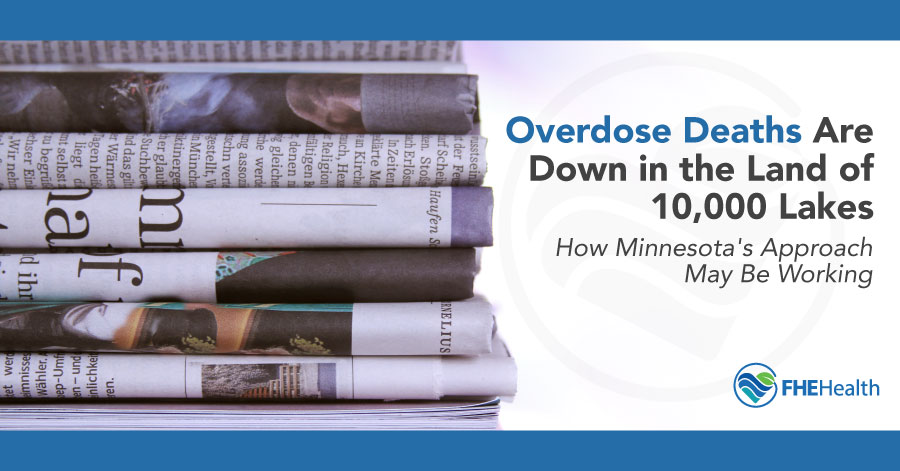
Following a broad range of efforts designed to combat soaring drug overdose deaths, Minnesota’s approach may be working. In 2017, 422 Minnesota residents died from an opioid overdose. Recognizing that these numbers were only continuing to rise from year to year, Minnesota decided to take action. The results thus far are noteworthy….
Minnesota Launched a Drug Overdose Prevention Program
The devastating effects of fatal drug overdoses can impact families, children, businesses and the whole community. The Minnesota Department of Health (MDH) launched an opioid overdose prevention program in 2017 to battle the mounting drug problem in the state.
The initiative includes the following:
- Data including an opioid dashboard and overdose death reporting
- Substance abuse pilot surveillance system
- Community response efforts engaging the faith communities
- Basic information about the harms of drug use
Opioid Epidemic Response: Employer Toolkit
The Employer Toolkit was developed to help employers identify early signs of drug use and take an active role in response to the opioid epidemic. The five-step guideline helps businesses to recognize and address substance abuse at work. Empowering communities to become part of the solution is one of the factors that have made the prevention program successful.
Local Law Enforcement Initiatives
The statewide prevention program includes encouraging local law enforcement agencies to engage in a more holistic approach to reducing drug abuse. Duluth Police Department now employs opioid program technicians who follow up with overdose victims and provide chemical dependency assessment referrals. The purpose of the program is to make help available to those who want it but may not know where to go.
Minnesota Law Actively Targets Drug Manufacturers and Distributors
According to newly released reports, in 2018 there were 607 fatal drug overdoses in Minnesota, down 17 percent on the year before, when there were 733. Opioid deaths declined by 22 percent from the previous year. According to the Minnesota Department of Health, opioid overdose deaths also decreased by 32 percent.
Minnesota lawmakers have been aggressively taking steps to change laws designed to halt the drug supply chain. Several new laws shift the onus of drug overdose to the drug makers and distributors, forcing them to pay the price for the epidemic. Governor Tim Walz signed a bill into law that makes it easier for the state to go after the source.
The bill also imposes increased registration fees on prescription drug manufacturers and distributors. These are expected to raise $21 million/year. The money is in turn being used to provide grants for prevention programs, interventions and treatment. A fund is also being created to offset the growing child protection service costs resulting from drug-addicted parents.
The bill has caught the attention of other states who are considering replicating it to relieve the financial burden of drug abuse in their respective states.
Medical Providers Are Part of the Solution
Minnesota has also taken efforts to curb addiction by enforcing new guidelines for medical providers who prescribe opioids to patients who belong to Minnesota Medicaid health plans. It is estimated that more than 16,000 health care providers serving Minnesota residents who receive state-subsidized healthcare will receive reports with data about the rates at which both they and their peers are prescribing addictive prescription drugs.
If the provider scores outside and higher than the recommended guidelines, they will be provided an opportunity to improve. If they fail to meet the guidelines within the allotted time period, they will undergo a program and monitoring. Addressing medical providers as part of the solution is one more way that Minnesota has committed to approach the drug overdose crisis from all sides.
The Role of Law Enforcement in Overdose Decline
The Drug Enforcement Administration (DEA) reports that drug seizures have risen substantially in Minnesota. The agency has seized 761 pounds of methamphetamine alone to date this year. In 2017, the DEA seized 871 pounds over the course of the entire year. Drug seizures have increased across the country, but have an increased impact in Minnesota when considered as a part of their other efforts.
Minnesota Viewed As a Success Model
The holistic approach employed by the state of Minnesota may become a template for other states to follow. To date, the combination of prevention efforts, community policing, legislature, and aggressive drug seizures are proving a recipe for substantial decline of drug overdoses. If the 2019 year end data demonstrates another sharp decline in opioid drug overdose in the state, look for states across the country to apply similar approaches with hopes of achieving the same positive results.






